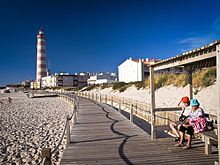Aveiro Lighthouse

A contextual view of the lighthouse along the coast of Gafanha da Nazaré
|
|
|
Position of the lighthouse within continental Porutgal
|
|
| Location |
|
|---|---|
| Coordinates | 40°38′34.14″N 8°44′52.07″W / 40.6428167°N 8.7477972°WCoordinates: 40°38′34.14″N 8°44′52.07″W / 40.6428167°N 8.7477972°W |
| Year first constructed | 1893 |
| Automated | 1990 |
| Foundation | 2-story keeper's house |
| Construction | stone tower |
| Tower shape | cylindrical tower with balcony and lantern |
| Markings / pattern | red and white bands tower, red lantern |
| Height | 203 feet (62 m) |
| Focal height | 217 feet (66 m) |
| Original lens | 3rd order Fresnel lens |
| Light source | mains power |
| Range | 23 nautical miles (43 km; 26 mi) |
| Characteristic | Fl (4) W 13s. |
| Admiralty number | D2056 |
| NGA number | 113-3272 |
| ARLHS number | POR-101 |
| Portugal number | PT-095 |
| Managing agent | Direcção de Faróis (Directorate for Lighthouses) |
| Heritage | Unclassified |
The Lighthouse of Praia da Barra, also known as the Aveiro Lighthouse (Portuguese: Farol de Aveiro/Farol da Praia da Barra) is an active lighthouse in the civil parish of Gafanha da Nazaré, municipality of Ílhavo, in the Portuguese district of Aveiro. Situated on the coastal Praia da Barra, at the southern margin of the Ria de Aveiro, it is the tallest lighthouse in Portugal, with a height of 203 feet (62 m) overseeing the barrier beach and exposed to Atlantic storms. Open to the public, visits are held Wednesdays from 14:00 to 17:00.
On 8 January 1856, a dispatch determined the need for a lighthouse along the coastal area at the mouth of the Ria de Aveiro; the Director das Obras Públicas do Distrito de Aveiro (Aveiro District Director of Public Works), in accordance with the Porto captaincy and Director Maquinista de Faróis (Lighthouse Mechanical Director), indicated the appropriate location for a new lighthouse. The authorities had rejected the idea of reusing the signal tower from the Fort of Barra in order to construct the Barra light in 1858. On 14 October 1870, by dispatch a general illumination plan was approved for the coast, elaborated by counsel Franciso Maria Pereira da Silva. The plan for the lighthouse was approved in 1879, that included an octagonal tower of 55 metres (180 ft) high.
The construction of the lighthouse occurred between 1879 and 1893, after alterations to the original project. This lighthouse replaced the services of the Hermitage of Senhora das Areias which, from the writings of friar Agostinho de Santa Maria:
The build was initially under the direction of engineer Silvério Pereira da Silva and later by engineer José Maria de Mello e Matos, envisioning a budget of 51 contos de réis and an elevator that would eliminate the need for a 228 step winding staircase. The first beacon was an incandescent petrol lamp and horn combination and began to operating on 15 October 1893. The lighthouse would later be supported by a first-order lamp, with four clarions, oscillating at 2.5 seconds and with a 1.5 eclipse, and a 9.5 second interval, that allowed it to reach 20 nautical miles (37 km). In addition, the Holmes fog signal was installed at the same time to provide a warning in the fog.
...
Wikipedia

